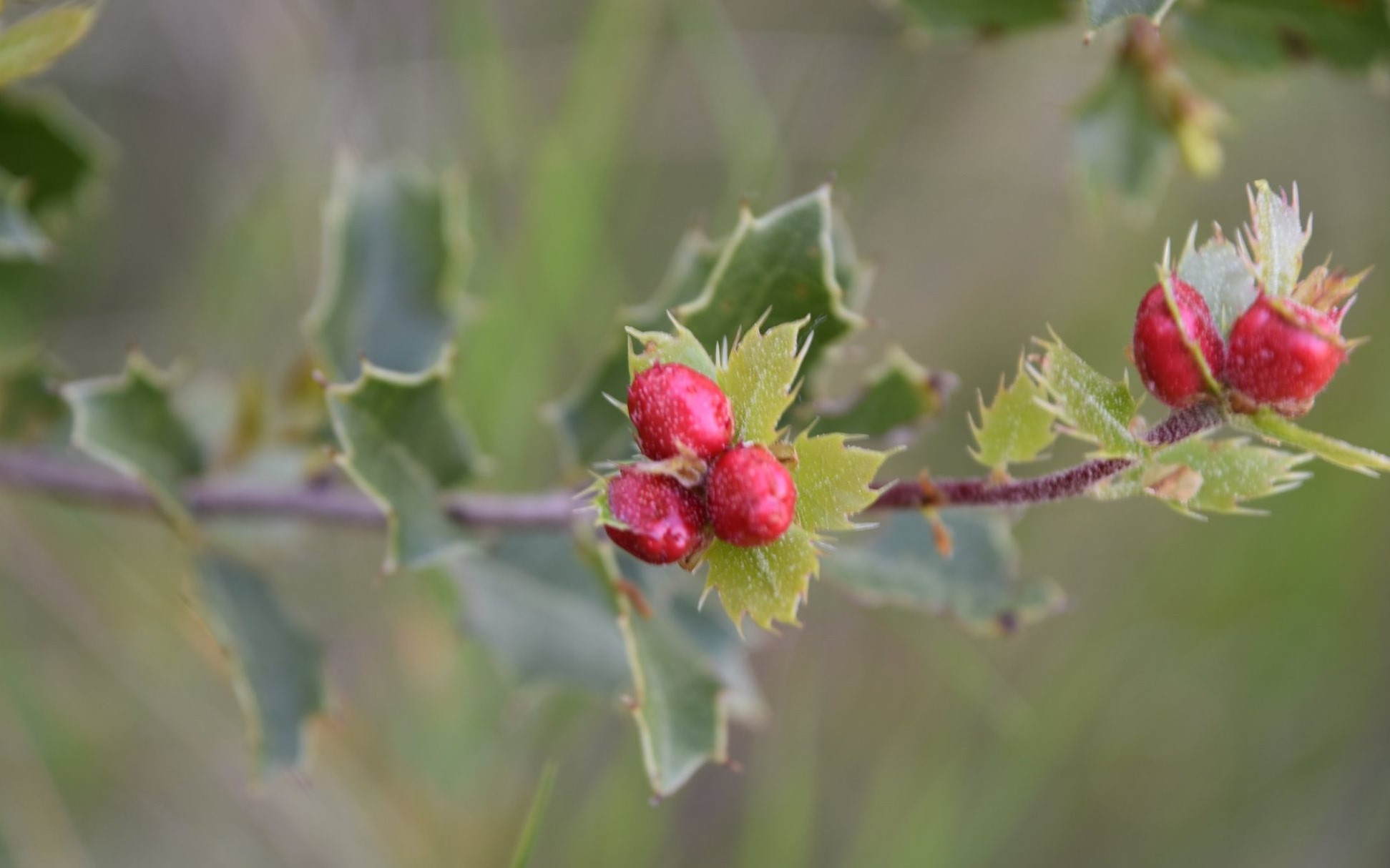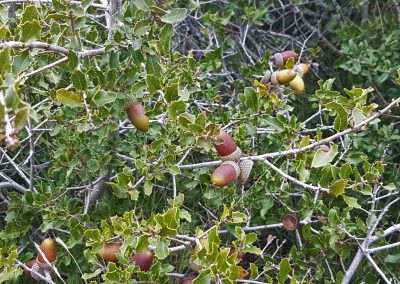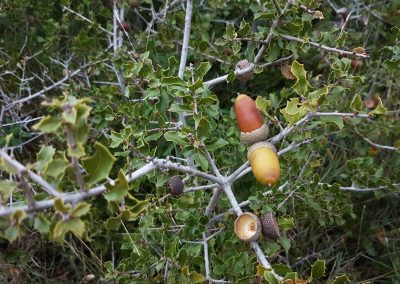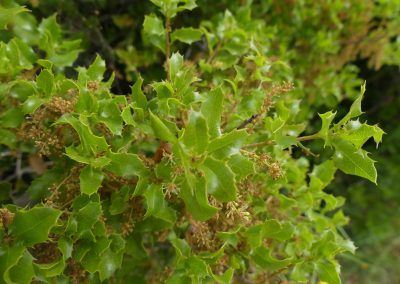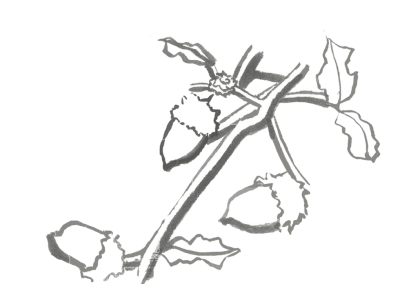Quercus coccifera
Scientific description
Taxon: Quercus coccifera
Class: Magnoliopsida
Subclass: Rosidae
Order: Fagales
Family: Fagaceae
Common name: Kermes oak
Origin:
Mediterranean Basin (Southern Europe, North Africa).
Description:
Persistent shrub or small tree, often twisted and spiny, 2–5 m tall. Tough, oval to elliptical leaves, deeply lobed or toothed, spiny edges, dark glossy green above, lighter below. Small round acorns hidden in scaly cupules. Forms dense thickets typical of Mediterranean maquis. Adapted to dry and poor soils, resistant to drought, wind, and fire. Hard, dense wood.
Propagation:
By seeds (acorns) germinating in spring, sometimes after dormancy. Vegetative reproduction rare.
Ecology:
Pioneer species stabilizing Mediterranean maquis. Tolerates calcareous, sandy, rocky soils. Provides habitat and food for wildlife.
Use:
Wood for charcoal and traditional tools. Ornamental for hedges and windbreaks. Acorns feed livestock.
Threat:
Not threatened, sensitive to urbanization and intensive overgrazing.
Taxon: Quercus coccifera
Classe: Magnoliopsida
Sous-classe: Rosidae
Ordre: Fagales
Famille: Fagacées
Nom commun: Chêne kermès
Origine:
Bassin méditerranéen (Europe du Sud, Afrique du Nord).
Description:
Arbuste ou petit arbre persistant, souvent tortueux et épineux, 2–5 m de hauteur. Feuilles coriaces, ovales à elliptiques, profondément lobées ou dentées, bords souvent épineux, vert foncé brillant dessus, plus clair dessous. Petits glands ronds dans une cupule écailleuse. Forme des fourrés denses typiques des maquis méditerranéens. Résiste à la sécheresse, au vent et au feu. Bois dur et dense.
Propagation:
Par graines (glands) germent au printemps, parfois après dormance. Reproduction végétative rare.
Écologie:
Espèce pionnière et stabilisatrice du maquis méditerranéen. Tolère sols calcaires, sableux et rocheux. Fournit habitat et nourriture à la faune locale.
Utilisation:
Bois pour charbon et fabrication d’outils traditionnels. Plante ornementale pour haies et brise-vent. Glands pour le bétail.
Menace:
Non menacée, sensible à l’urbanisation et au surpâturage intensif.
Taxon: Quercus coccifera
Clasă: Magnoliopsida
Subclasă: Rosidae
Ordin: Fagales
Familie: Fagaceae
Nume comun: Stejarul kermes
Origine:
Bazinul Mediteranean (Sudul Europei, Africa de Nord).
Descriere:
Arbust sau copac mic persistent, adesea răsucit și spinos, 2–5 m. Frunze tari, ovale până la eliptice, profund lobate sau dințate, margini spinoase, verde lucios sus, mai deschis dedesubt. Ghinde mici, rotunde, ascunse în cupule solzoase. Formează tufișuri dense tipice maquis-ului mediteranean. Rezistă la secetă, vânt și foc. Lemn dur și dens.
Propagare:
Prin semințe (ghinde) primăvara, uneori după repaus. Reproducere vegetativă rară.
Ecologie:
Specie pionieră, stabilizatoare a maquis-ului mediteranean. Tolerează soluri calcaroase, nisipoase și stâncoase. Oferă habitat și hrană faunei locale.
Utilizare:
Lemn pentru cărbune și unelte tradiționale. Plantă ornamentală pentru garduri vii și perdele de vânt. Ghindele hrănesc animalele domestice.
Amenințare:
Nu este amenințată, dar sensibilă la urbanizare și pășunat excesiv intensiv.
Ταξινόμηση: Quercus coccifera
Κλάση: Magnoliopsida
Υποκλάση: Rosidae
Τάξη: Fagales
Οικογένεια: Fagaceae
Κοινή ονομασία: Κερασιά (Κερμέζι)
Προέλευση:
Μεσογειακή λεκάνη (Νότια Ευρώπη, Βόρεια Αφρική).
Περιγραφή:
Αειθαλής θάμνος ή μικρό δέντρο, συχνά παραμορφωμένο και αγκαθωτό, 2–5 μ. Σκληρά, ωοειδή έως ελλειπτικά φύλλα, βαθιά λοβωτά ή οδοντωτά, αγκαθωτά άκρα, σκουροπράσινα και γυαλιστερά πάνω, πιο ανοιχτόχρωμα κάτω. Μικρές στρογγυλές βελανιδιές σε φολιδωτό κάλυκα. Δημιουργεί πυκνούς θάμνους τυπικούς της μακίας. Αντέχει στη ξηρασία, τον άνεμο και τη φωτιά. Σκληρό, πυκνό ξύλο.
Διάδοση:
Με σπόρους (βελανιδιές) την άνοιξη, μερικές φορές μετά από λήθαργο. Αζυγογονία σπάνια.
Οικολογία:
Είδος πρωτοπόρο και σταθεροποιητής της μεσογειακής μακίας. Αντέχει σε ασβεστολιθικά, αμμώδη και πετρώδη εδάφη. Παρέχει καταφύγιο και τροφή στην τοπική πανίδα.
Χρήση:
Ξύλο για κάρβουνο και παραδοσιακά εργαλεία. Διακοσμητικό για φράχτες και ανεμοφράκτες. Βελανιδιές τρέφουν τα ζώα.
Απειλή:
Δεν απειλείται, ευαίσθητο σε αστικοποίηση και εντατική υπερβόσκηση.
Creative writing inspired by Quercus coccifera
The kermes oak
Once upon a time, in a verdant valley, there lived an old oak tree. Its branches reached for the sky and its roots embraced the earth like a mother protecting her children. It was the wisest and strongest oak in the whole forest, and all its inhabitants - birds, rabbits, squirrels and forest sprites - took refuge in its shade.
But one day, a great evil approached the valley. A cruel king from a faraway land decided to build a castle where the forest once stood. He sent his woodcutters to cut down all the trees, even the sacred oak.
The animals and elves were terrified. “What are we going to do ?” they asked the oak.
The oak smiled wisely and said, “Don’t be scared, nature always finds a way.”
That evening, a violent wind picked up. The oak's leaves whirled and one of its acorns fell gently to the ground. Out came a little fairy, Tina, who was the spirit of the forest.
With a gentle gesture, the oak's roots sprouted and spread everywhere. The next day, when the woodcutters tried to chop down the trunk, the roots rebounded and prevented them from doing so. Every time one of them lifted the axe, the tree's branches whispered ancient words from the wind, causing them to feel a deep sadness in their hearts.
The king, seeing that no one dared cut the oak, decided to leave it alone. And, miraculously, the forest began to grow again, full of life and magic.
The wise oak stayed put, offering shelter and hope to all. And every time a child plants a seed in the earth, Tina's spirit whispers wishes for a future full of life and greenery.


